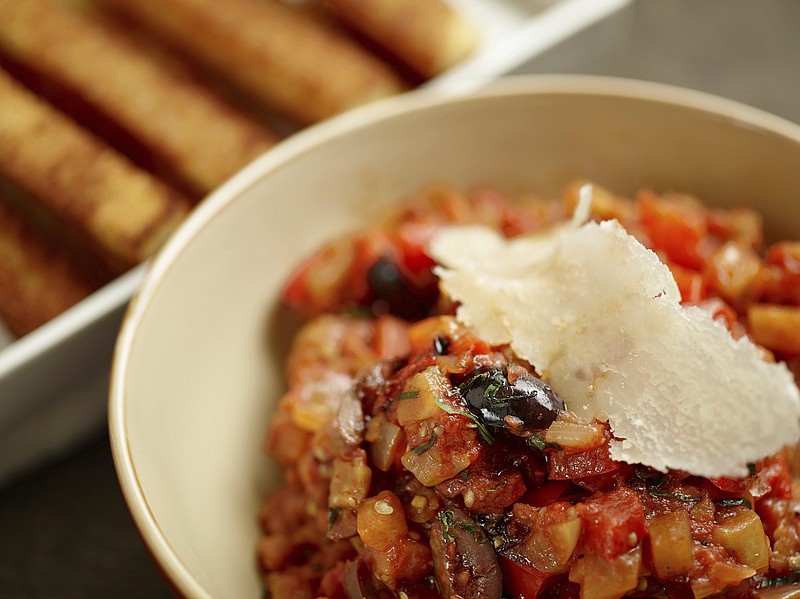Traditional recipes seem to be part of a collective conscience of sorts, and eggplant caponata is no exception. All around Italy (and the world), chefs and grandmothers and uncles are making a variation of this sweet and sour eggplant dish. And while each region and family has its own variation on method and ingredients, the same overall idea prevails.
In the simplest of terms, eggplant caponata is cooked eggplant and other ingredients in a sweet and sour sauce. Those "other ingredients" can be a number of things, but most commonly include peppers, onions, garlic, raisins and capers. The beauty of caponata is it can be made in advance and served at room temperature and it's a perfect accompaniment to meat or fish or on top of crostini.
In Italian cooking, the combination of sweet and sour flavors is known as agrodolce. It typically refers to a cooked mixture of vinegar and sugar or other sweetener, and can be served over roasted meats, on toasted panini, or as an ingredient in a composed pasta dish. In eggplant caponata, it is the sauce that binds the other ingredients together, giving the dish its characteristic sweet and sour qualities.
In this version, the vegetables are tossed with vinegar and tomatoes, then roasted in a single layer until they are soft and caramelized. Because eggplant holds so much moisture, it is often salted and drained before cooking. Excess moisture in an ingredient can keep it from browning, but will also make the overall dish soggy and less flavorful. Salting the eggplant will help ensure the caramelization that puts the "dolce" in agrodolce.
EGGPLANT CAPONATA
Makes 10 servings (about 6 cups)
Start to finish: 1 hour 45 minutes (Active time: 15 minutes)
1 eggplant (about 1 pound), peeled and cut into small dice
2 tablespoons salt
1 red bell pepper, seeded and cut into small dice
3/4 cup minced onion
1 teaspoon minced garlic
1/4 cup olive oil
2 cups canned diced tomatoes
2 tablespoons tomato paste
2 tablespoons basil chiffonade
1 teaspoon minced marjoram
1 tablespoon balsamic vinegar
1/3 cup finely grated Parmesan
Preheat the oven to 250 F.
Place the eggplant in a large bowl and sprinkle with the salt, tossing evenly to distribute. Place the salted eggplant in a colander and allow to drain for 20 minutes.
Quickly rinse the eggplant under cool water, then place on paper towels to absorb excess moisture.
In a large bowl, combine the eggplant with the bell pepper, onion, garlic, and oil and toss to combine. Add the tomatoes and tomato paste and toss to thoroughly combine.
Spread the vegetable mixture evenly on a baking sheet and roast for about 45 minutes, or until the vegetables are tender and lightly browned.
Remove the pan from the oven and add the basil, marjoram, and vinegar. Gently fold the ingredients together.
Transfer the caponata to a glass or stainless steel container with a lid. Let cool to room temperature, then stir in the cheese. Refrigerate the caponata in a covered glass or stainless steel container for up to a week. The flavor will improve if the caponata is allowed to rest for at least 24 hours before use.
___
Nutrition information per serving: 114 calories; 56 calories from fat; 6 g fat (1 g saturated; 0 g trans fats); 2 mg cholesterol; 527 mg sodium; 13 g carbohydrate; 3 g fiber; 7 g sugar; 2 g protein.
___
This article was provided to The Associated Press by The Culinary Institute of America in Hyde Park, New York.

